
Home - AFV Events - Auto Shows - 2014 L.A. Auto Show
It's been a decade since I posted a report from the Los Angeles Auto Show, because a move from California to Hawaii and the demands of raising two young kids have left me with no time to update this website since about 2006. However, with a combination of well-timed business trips (I kept my L.A. area job as an "extreme telecommuter" when we moved out of state, and I go back a few times a year) and the occasional "just go!" from my very understanding wife, I have continued to attend each year (in fact, I haven't missed one in almost three decades!). I hope to post my photos of developments during those missing years, but for now, here is a report on the 2014 show, held at the L.A. Convention Center 21-30 November 2014, which I attended on 26 November 2014. (In 2006 the show moved from January to November/December, so this show was for the 2015 model year. They also dropped "Greater" from the show's name at some point during the hiatus.)

Over the last few years, battery-electric vehicles (EVs) have made a big comeback, and plug-in hybrid vehicles (PHEVs) have come on the scene. Regrettably, my family needed a new vehicle when we moved at the end of 2007, not at the end of 2010, so I had to settle for a non-plug-in Prius instead of catching this wave. (In a few years, I hope...) Hybrid-electric vehicles have become so much a part of the mainstream, with so many models available, that I don't even bother keeping track of non-plug-in models any more when I go to an auto show; I've been pleased to see many more battery EVs and plug-in hybrids lately, and I'll show plenty of photos below, but for me the biggest news at this year's auto show was the Toyota Mirai fuel cell vehicle (FCV), powered by hydrogen fuel.
Automakers have been building prototype FCVs for over a decade; the first one I saw was the Honda FCX at the 2002 L.A. Auto Show, I first rode in a Hyundai Santa Fe at a FCV road rally later in 2002, and I was actually allowed to drive (briefly) another million-dollar prototype, the GM HydroGen3, at the Electric Vehicle Symposium the following year. Around that time automakers started leasing a very small number of the vehicles to utilities and governments, and a few years later another very small number were leased to private citizens; the reason I was particularly impressed by the Mirai (the name is the Japanese word for "future," I'm told) is that Toyota is actually planning to sell the vehicle in Fall 2015! This is a huge deal for those of us who have been involved with alternative-fueled vehicles since the 1990s, because most of the EVs built during the brief flowering at the end of that decade were only made available for lease, never actually sold to drivers. This meant that when the automakers had succeeded in grinding away California's mandate that they put these vehicles on the road, they were able to stop making them, stop renewing the leases, and take them back for destruction or at best mothballing in museums. The expected price of the Mirai was quoted to me as $57,000, or $45,000 after incentives, and only in California at first; of much more interest to me than the price, though, was that there actually is a purchase price. (There was also a Hyundai Tucson FCV present that is available "in limited ZIP Codes," but only for lease.)
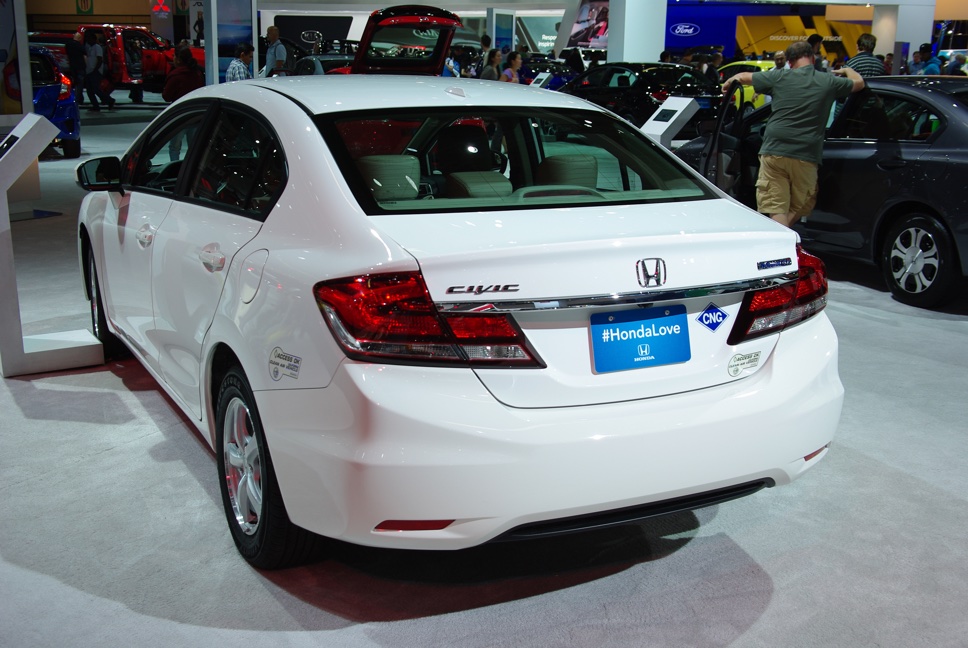
However, I am not ready to let down my guard about automaker commitment to FCVs, let alone believe the promises that they are a viable replacement for battery EVs (Toyota introduced a new version of the electric RAV4-EV a few years ago, but has now discontinued them, citing the readiness of FCVs to take their place). A big part of the reason for my skepticism is the way that every automaker except Honda has conducted themselves with regard to vehicles powered by compressed natural gas (CNG) over the past couple of decades. The photo above shows a current model-year Honda Civic running on this fuel; this car has roots going back to the Civic GX introduced in 1998 and marketed to the public (not only to fleets, as at the outset) starting in 2005. Other automakers produced CNG versions of their own vehicles, including my 1993 Dodge van, but by the 2007 model year all of them had disappeared from the market except the Civic. (Aftermarket companies continue to develop conversion kits for popular fleet vehicles like pickups, but the automakers themselves bailed out.) As I argued in detail elsewhere on this website as far back as 2004, the path to mass commercialization of CNG vehicles was a lot easier than that for hydrogen would be; and yet automakers except for Honda found it too difficult to persevere with CNG. California has a plan now, combining commercial and state funding, to have 48 hydrogen fueling stations by 2016, and 100 spread across the state over the next several years, so as to enable for example a drive from Los Angeles to San Francisco; but again, we've heard these promises before. In other words, check back with me in several years; if the vehicles are still being offered for sale (not only lease), in increasing numbers, and the number of refueling stations is also increasing, then I'll count myself convinced. "I'm from Missouri; you have to show me."
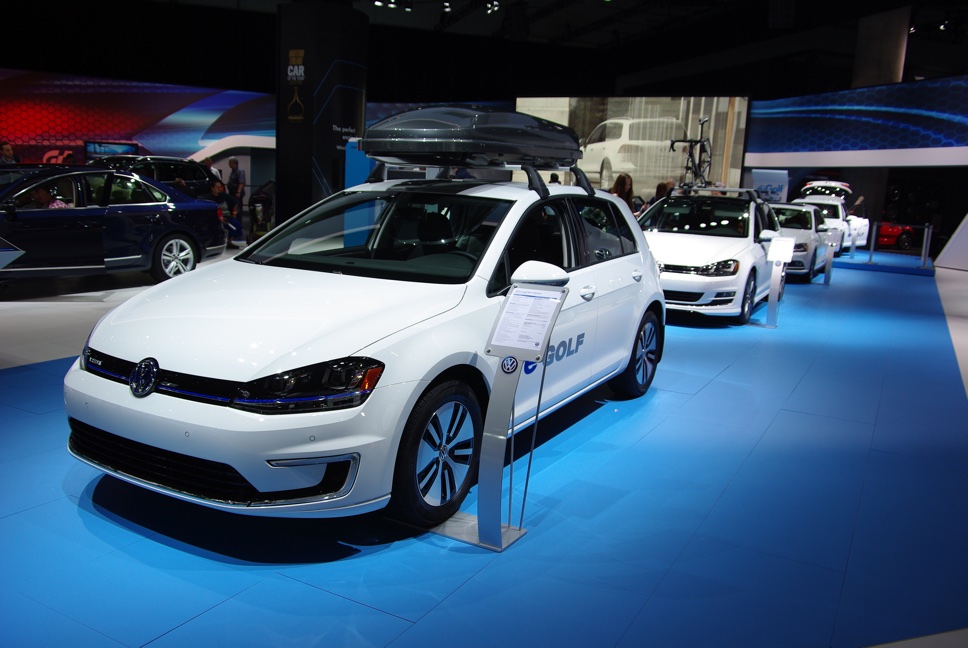
Well, enough argumentation about the past and future; in the present, as I noted, there are many plug-in vehicles, both pure battery electric (EVs) and hybrid-electric vehicles that supplement their gasoline fuel tanks with plug-in batteries (PHEVs), at this auto show. A very pleasant change that occurred while this website was on hiatus! I hope to document the transition by posting reports covering this time period; of particular interest to me, though, is how automakers that have in the past bad-mouthed EVs are now on board with their own models. I noticed at the L.A. Auto Show six years ago that the automakers with hydrogen vehicles on display seemed a bit defensive in some of their signage, as it was becoming clear that a new wave of electric plug-in vehicles was coming; however, for many years before that some automakers with a heavy investment in diesel power have talked up the efficiency of those vehicles in the face not only of plug-ins but even of ordinary non-plug-in hybrids. One of these was Volkswagen; however, at this show the lineup of Golf models shown above was led by the e-Golf, an EV which was slated to be available in California in early 2015, for sale or lease.

Another surprising commitment to plug-in vehicles, given past rhetoric, is from BMW. In the foreground is the i3, a compact vehicle that I first saw on the road in Hawaii a couple of months before this auto show. It is a battery EV, but BMW has just started including a small gasoline range-extender engine and generator that will start up to recharge the battery if it is getting low while out driving, and as I understand it BMW will be offering this as a retrofit to i3 owners who bought the vehicle before it was available. The other car is the i8, a premium high-performance PHEV (with a premium price three times that of the i3...). BMW was also showing a concept SUV at the show, an X5 with a drivetrain derived from the i8.

Climbing even further up into the premium high-performance PHEV stratosphere are the Porsche Panamera S E-Hybrid (middle), new Cayenne S E-Hybrid with a similar powertrain (background), and the super-premium, super-sport 918 Spyder (foreground) with combined gasoline/electric output of 608 HP and a price tag of nearly a million dollars.

Back in a less rarefied price range, Ford showed this lineup of their plug-in and hybrid vehicles. In the foreground, in front of the C-Max Energi PHEV and other hybrids, is the new 2015 Focus EV, scheduled to become available in early 2015. I am always pleased to see new generations of alternative-fueled vehicles, and that's one reason I always keep an eye out each year for the CNG Honda Civic shown above. At the 2002 L.A. Auto Show, I noted that the RAV4-EV on display was based on the older body, not updated alongside the gasoline models that year, and I took that to be a sign (accurately, as it turned out) that the model was not going to be offered for much longer. (There was a decade-long gap between the discontinuation of the original RAV4-EV and the introduction of the modern one, now also discontinued.)
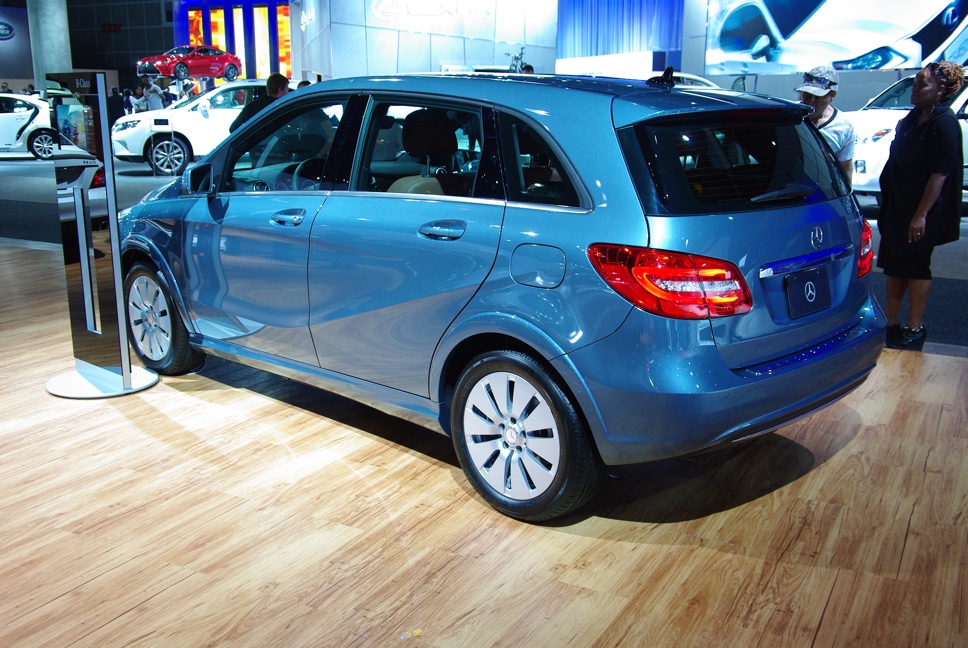
Mercedes Benz is rolling out some new models, with availability in only ten states initially; this is the B-Class Electric, a battery EV, and in Spring 2015 there will be a PHEV version of the S550.
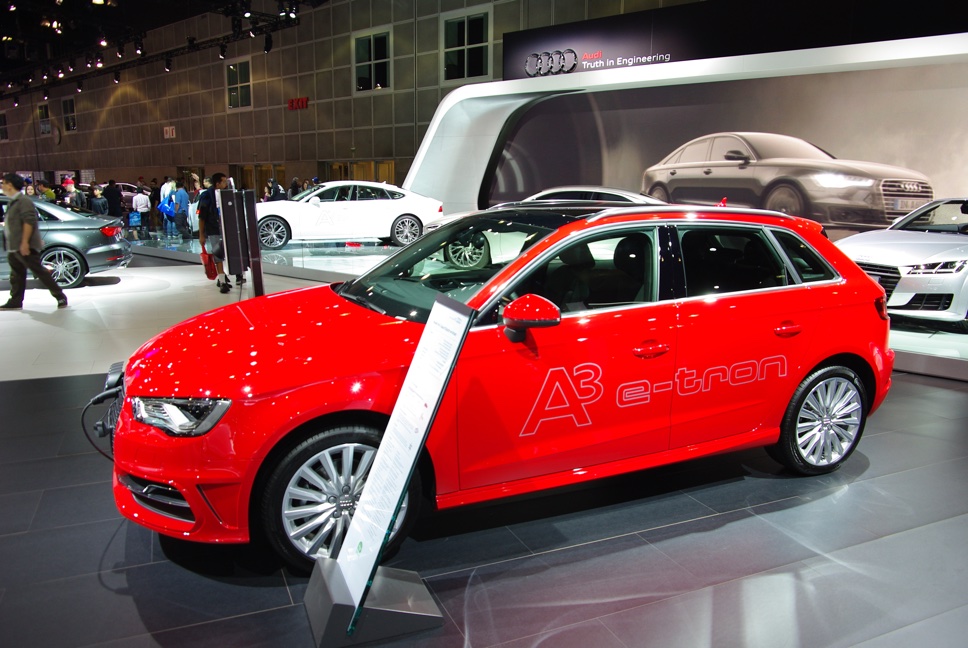
Audi will start selling this A3 e-tron PHEV in Summer 2015. The white car overexposed in the background (sorry, I'm not a great photographer) is the A7 h-tron FCV concept car.
This report is getting pretty long; plug-in vehicles have gotten so popular that I have to cull the list of ones to show on the page. Also present were the Chevrolet Spark EV, which has been available for a couple of years in California and Oregon; I understand it is to be phased out in favor of a new dedicated EV (as opposed to this adaptation of the gasoline Spark, say), called the Bolt. The Chevrolet Volt will have a second generation in 2016, running on regular rather than premium gas among other improvements. The Fiat 500e EV is available in California and Oregon; the Honda Fit EV is out of production, but a new Accord PHEV came out last year. Volvo showed the new XC90 T8, a PHEV AWD SUV (lots of alphabet soup). A Smart EV is becoming broadly available, "wherever there's a Smart dealer" or so I'm told, though the signage still said you could only "pre-register" your interest. And in the "Aftermarket and Performance" third-party display area in another hall was the Mullen 700e, which is a resurrection of the Coda from a few years back (a four-door EV sedan with a UQM drivetrain and lithium iron phosphate battery pack), and a display from ZElectric Motors, who will convert a classic VW Bug to an EV for you.
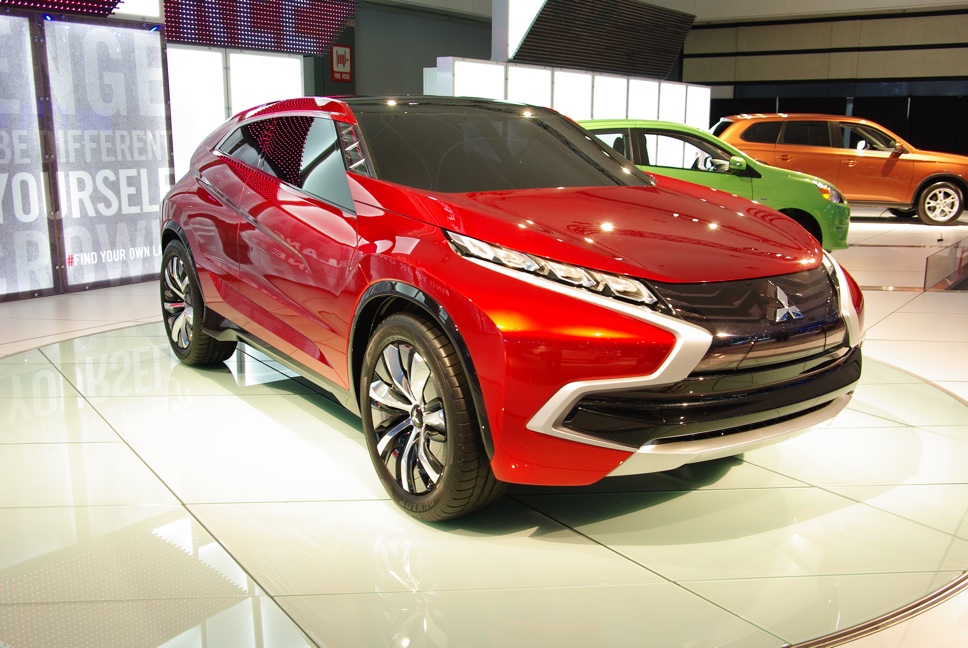
The Mitsubishi i-MiEV was there, and with an MSRP of $22,995 it is a lot less expensive than some of the other vehicles discussed above (a third cheaper than the Fiat 500e or e-Golf, half the price of the BMW i3 or Mercedes Benz B-Class EV, and let's not think about the BMW i8 or the Porsches). Mitsubishi also brought the Concept XR-PHEV vehicle shown above, which as its name implies is a PHEV concept SUV.
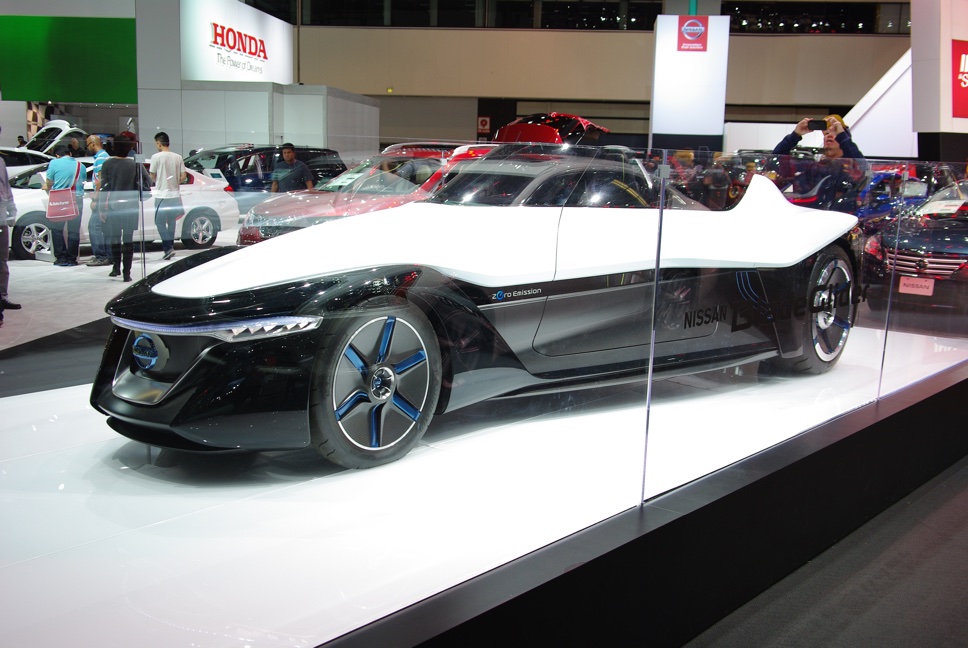
Another affordable EV is the Nissan Leaf; in Hawaii I can't drive more than a mile on a major road without seeing a couple of them, it seems. It's getting the kind of "mindshare" that the Prius earned in the early days of hybrids; people heard "hybrid" and thought "Prius," and in Hawaii at least they hear "electric vehicle" today and think "Leaf." In addition to the Leaf, Nissan brought this "rail job"-looking BladeGlider concept EV.
Well, this will be among the first webpages I "advertise" using Facebook, Twitter, etc.; if you came here via one of those modern routes, this is probably the first page you'll see on the website, so welcome! Now that I've "relaunched" the website, I hope to continue reporting on developments in this arena for as long as alternative fuels remain "alternative."
 Back
to AFV Events Page
Back
to AFV Events Page Back
to Fueling Station
Back
to Fueling Station Site
Map
Site
Map Contact
Me
Contact
Me All content copyright 1998-2024 by Mark Looper, except as noted. Reuse of my copyrighted material is authorized under Creative Commons Attribution 4.0 International license (CC BY 4.0).
![]()
![]()
new 31 May 2015